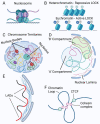Nuclear Dynamics and Chromatin Structure: Implications for Pancreatic Cancer
- PMID: 34685604
- PMCID: PMC8534098
- DOI: 10.3390/cells10102624
Nuclear Dynamics and Chromatin Structure: Implications for Pancreatic Cancer
Abstract
Changes in nuclear shape have been extensively associated with the dynamics and functionality of cancer cells. In most normal cells, nuclei have a regular ellipsoid shape and minimal variation in nuclear size; however, an irregular nuclear contour and abnormal nuclear size is often observed in cancer, including pancreatic cancer. Furthermore, alterations in nuclear morphology have become the 'gold standard' for tumor staging and grading. Beyond the utility of altered nuclear morphology as a diagnostic tool in cancer, the implications of altered nuclear structure for the biology and behavior of cancer cells are profound as changes in nuclear morphology could impact cellular responses to physical strain, adaptation during migration, chromatin organization, and gene expression. Here, we aim to highlight and discuss the factors that regulate nuclear dynamics and their implications for pancreatic cancer biology.
Keywords: chromatin; gene expression; nuclear lamina; nuclear morphology; pancreatic cancer.
Conflict of interest statement
The authors declare no conflict of interest.
Figures



References
-
- Beale L.S. Results of the chemical and microscopical examination of solid organs and secretions. Examination of sputum from a case of cancer of the pharynx and the adjacent parts. Arch. Med. 1860;2:44–46.
-
- Papanicolaou G.N., Traut H.F. The diagnostic value of vaginal smears in carcinoma of the uterus 1941. Arch. Pathol. Lab. Med. 1997;121:211–224. - PubMed
Publication types
MeSH terms
Substances
Grants and funding
LinkOut - more resources
Full Text Sources
Medical

